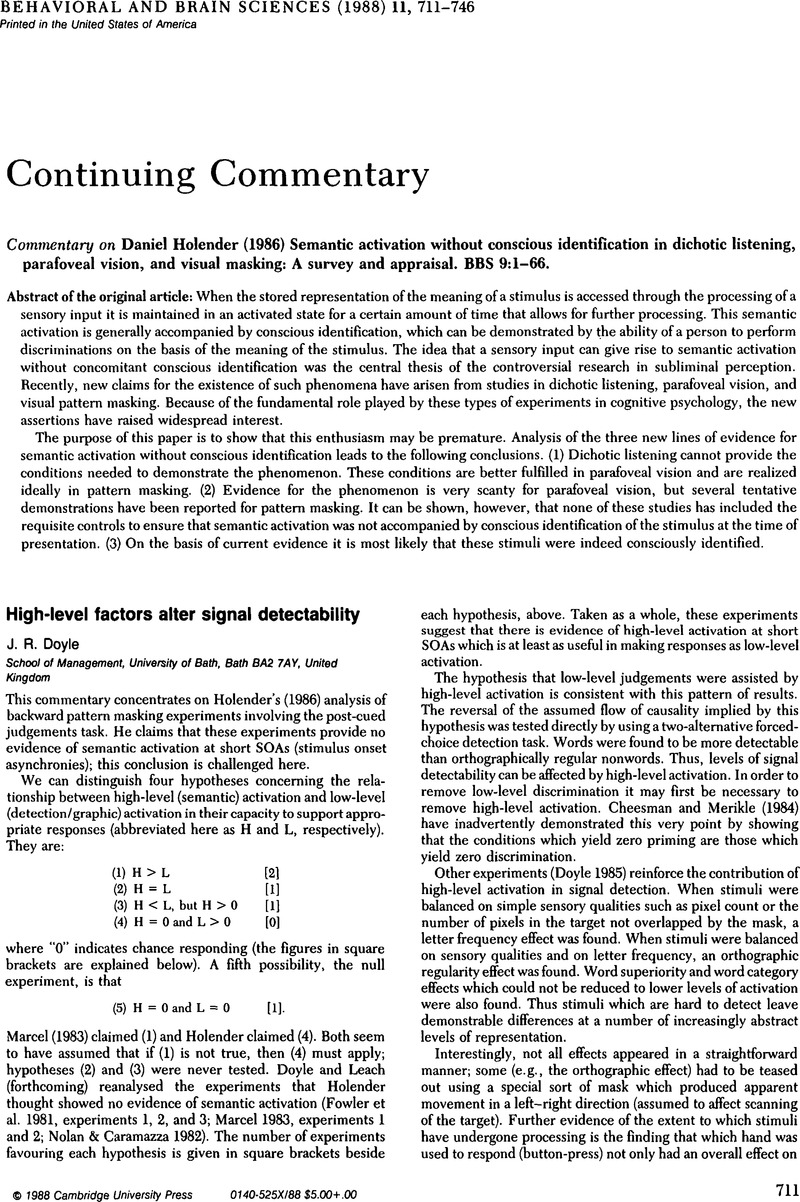Crossref Citations
This article has been cited by the following publications. This list is generated based on data provided by Crossref.
Shevrin, Howard
1991.
A lawful first-person psychology involving a causal consciousness: A psychoanalytic solution.
Behavioral and Brain Sciences,
Vol. 14,
Issue. 4,
p.
693.
Dagenbach, Dale
1991.
On the premature demise of causal functions for consciousness in human information processing.
Behavioral and Brain Sciences,
Vol. 14,
Issue. 4,
p.
675.
Wilson, Timothy D.
1991.
Consciousness: Limited but consequential.
Behavioral and Brain Sciences,
Vol. 14,
Issue. 4,
p.
701.
Wagstaff, Graham F.
1991.
No conscious or co-conscious?.
Behavioral and Brain Sciences,
Vol. 14,
Issue. 4,
p.
700.
Velmans, Max
1991.
Is human information processing conscious?.
Behavioral and Brain Sciences,
Vol. 14,
Issue. 4,
p.
651.
Hardcastle, Valerie Gray
1991.
Epiphenomenalism and the reduction of experience.
Behavioral and Brain Sciences,
Vol. 14,
Issue. 4,
p.
680.
Lloyd, Dan
1991.
Consciousness: Only introspective hindsight?.
Behavioral and Brain Sciences,
Vol. 14,
Issue. 4,
p.
686.
Foulkes, David
1991.
Dream processing.
Behavioral and Brain Sciences,
Vol. 14,
Issue. 4,
p.
678.
Mandler, George
1991.
The processing of information is not conscious, but its products often are.
Behavioral and Brain Sciences,
Vol. 14,
Issue. 4,
p.
688.
Koch, Christof
and
Crick, Francis
1991.
Understanding awareness at the neuronal level.
Behavioral and Brain Sciences,
Vol. 14,
Issue. 4,
p.
683.
Spiegel, David
1991.
Dissociating consciousness from cognition.
Behavioral and Brain Sciences,
Vol. 14,
Issue. 4,
p.
695.
Kinsbourne, Marcel
1991.
Velmans's overfocused perspective on consciousness.
Behavioral and Brain Sciences,
Vol. 14,
Issue. 4,
p.
682.
Economos, Judith
1991.
Observing protocol.
Behavioral and Brain Sciences,
Vol. 14,
Issue. 4,
p.
677.
Mangan, Bruce
1991.
Epi-arguments for epiphenomenalism.
Behavioral and Brain Sciences,
Vol. 14,
Issue. 4,
p.
689.
Block, Ned
1991.
Evidence against epiphenomenalism.
Behavioral and Brain Sciences,
Vol. 14,
Issue. 4,
p.
670.
Dretske, Fred
1991.
Conscious acts and their objects.
Behavioral and Brain Sciences,
Vol. 14,
Issue. 4,
p.
676.
Keane, Mark T.
1991.
Consciousness, analogy and creativity.
Behavioral and Brain Sciences,
Vol. 14,
Issue. 4,
p.
682.
Gregson, Robert A. M.
1991.
Has consciousness a sharp edge?.
Behavioral and Brain Sciences,
Vol. 14,
Issue. 4,
p.
679.
Dixon, N. F.
1991.
Hydrocephalus and “misapplied competence”: Awkward evidence for or against?.
Behavioral and Brain Sciences,
Vol. 14,
Issue. 4,
p.
675.
Gray, Jeffrey A.
1991.
What is the relation between language and consciousness?.
Behavioral and Brain Sciences,
Vol. 14,
Issue. 4,
p.
679.





